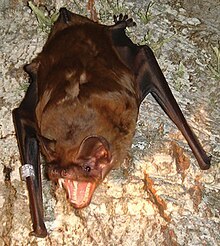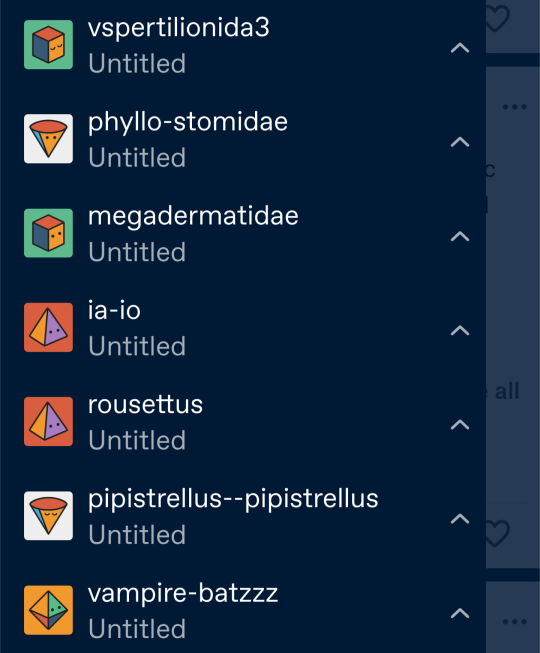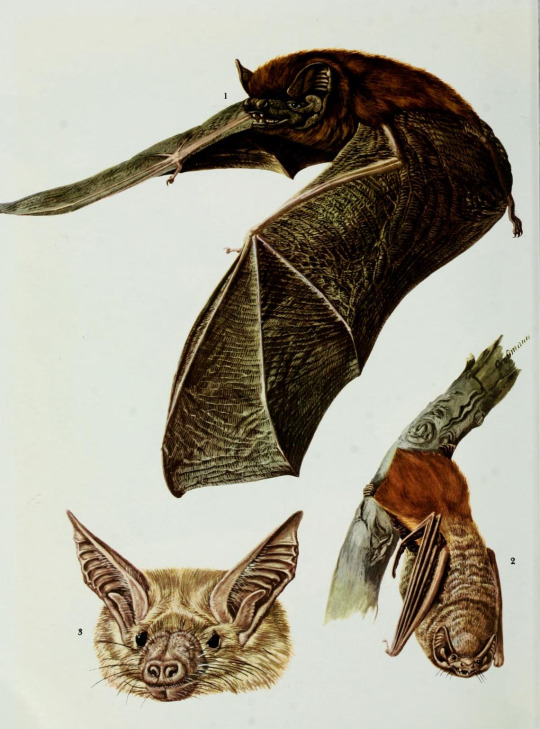#Nyctalus noctula
Explore tagged Tumblr posts
Text
today's dracula daily had me wondering what kind of bat dracula might be posing as, so I looked up a few things.
Largest species in the British Isles: Noctule Bat (Nyctalus noctula) with a wingspan of 32-40cm (12.6 to 15.7 inches) Another large bat species: Serotine Bat (Eptesicus serotinus) with a wingspan of 32-38cm (12.6 to 15.0 inches), less common species found in southern England and Wales Most common: Soprano Pipistrelle (Pipistrellus pygmaeus) with a wingspan of 19-23cm (7.5 to 9.1 inches) Second Most common: the visually nearly identical (though slightly bigger) Common Pipistrelle (Pipistrellus pipistrellus) with a wingspan up to 20cm (7.9 inches)
source for above: woodland trust
Now those would be the bats that Mina considers normal sized. Now bats certainly range much larger, such as the golden crowned flying fox with a wingspan of five feet. But I don't think we need to look so far from England for a bat that Dracula might turn into that Mina perhaps would view as "giant"
the largest species in mainland Europe is the greater noctule bat (Nyctalus lasiopterus), with a wingspan up to 46cm (18 in). The greater noctule bat is also one of the few bats known to eat passerine birds*, and the only species that hunts them on the wing (in flight) versus while roosting*.
It's rare in Romania, but it's there. And it looks incredibly adorable

image description: a chocolate brown bat with a silver band on one wing upside down on what appears to be either rock or wood, it is hard to tell for sure. The bat has its mouth open, displaying its teeth, including its pointy fangs. image source: wikipedia
*Aka perching birds. Think sparrows, songbirds, corvids. Passerines are a very diverse group of birds. *There may be another species of bat that also does this, the Great evening bat (Ia io) of eastern and southeastern Asia.
#dracula daily#noctule bat#greater noctule bat#nyctalus lasiopterus#great evening bat#ia io#Nyctalus noctula#serotine bat#Eptesicus serotinus#soprano pipistrelle#Pipistrellus pygmaeus#common pipistrelle#Pipistrellus pipistrellus#vampires#long post
346 notes
·
View notes
Note
sorry if you've talked about this before, but I'm curious if clanmew have different words for different bat species? they obviously differentiate insects and birds, but bat's are harder to distinguish at a glance. cats would have an advantage with their hearing, being able to hear bat's squeaks (and I think different species make different patterns and sounds?) but like. I don't remember how many bat species there are here (I think noctule, pipistrelle, greater horseshoe, lesser horseshoe, daubenton's, whiskered, barbastelle, and serotine? I mightve missed a couple), but I love bat's so thought I'd ask. pipistrelle are the most common though I'm from the south-east of England so I occasionally see daubenton's too.
FOUR bat species! Over here in the main entry for birds, check there if you'd like more trivia on them. Clan cats count them as very special, blessed songbirds.
The ones that Clan cats have words for so far;
Pipistrelle (Pipistrellus pipistrellus) = Popep
Soprano Pipistrelle (Pipistrellus pygmaeus) = Ipi'ip
Long-eared Brown Bat (Plecotus auritus) = Fepfr
Common Noctule (Nyctalus noctula) = Shi'po
There are four more kinds of bat, for EIGHT total in this region, that I have not yet described because I don't have good access to their song recordings (Even the main four were ass on butts to hunt down) If you have clear recordings of the songs of these four I'll add them too.
Pipistrellus nathusii
Nyctalus leisleri
Myotis daubentonii
Myotis nattereri
#Southeast England has more bat species#And more moth species funny enough#Because this region is a lot colder and further north#bats#And yeah Clan cats are better at distinguishing these because they are able to hear stuff we as humans can't#For example the Soprano Pipistrelle was only discovered pretty recently#But they've known about it for eons because its song is totally different
24 notes
·
View notes
Text

A Noctule Bat 🦇 (Nyctalus noctula) flutters above a meadow with a pond at sunset, in search of its prey, a white ermine moth (Spilosuma lubricipeda) I love to draw bats because of their elegant wings and feisty expressions. Media: pen and ink, Copic and Pantone markers, soft pastels
#katia hougaard#art#bat#cute animals#moths#pond#trees#pastoral beauty#sunset#nature art#pastel art#creepy cute#my artwork#alcohol markers#traditional art#pink and purple#british wildlife
5 notes
·
View notes
Note
Upon returning from a short time away, Emiel opened the door to his home. A ray of light shown in as the holy vampire entered into his house. His eyes scanned the somewhat dark interior, a reprieve from the harsh sun outside for his vampiric eyes. He immediately noticed an unfamiliar shape on the wall.
Nyctalus noctula, a common noctule bat. He immediately recognized it, being a polymath well-versed in many things. The bat was curled up clutching onto the wall, it's wings folded up under it giving it the appearance of a little loaf with small feets and ears poking out.
He could tell from hearing its little heart and its scent that it was very hungry and thirsty, the little bat was weakened and had come in as a result of hunger induced confusion and relative weakness and fatigue. The bat noticed his presence and chittered in fright, using echolocation to better see him. He heard its heart race, the bat was horribly afraid and regarded him with wide eyes.
// Hi anon!
I won't be answering this ask from Regis' point of view because you've done too much of writing my muse for me - something I don't appreciate. Please refrain from describing what Regis does or thinks if you send me any asks/prompts.
Setting the scene and describing what npcs do is perfectly fine of course but leave my muse to me, please :)
2 notes
·
View notes
Text
Collision risk and habitat loss: Wind turbines in forests impair threatened bat species
https://sciencespies.com/nature/collision-risk-and-habitat-loss-wind-turbines-in-forests-impair-threatened-bat-species/
Collision risk and habitat loss: Wind turbines in forests impair threatened bat species
In order to meet climate protection goals, renewable energies are booming — often wind power. More than 30,000 turbines have already been installed on the German mainland so far, and the industry is currently scrambling to locate increasingly rare suitable sites. Thus, forests are coming into focus as potential sites. A scientific team from the Leibniz Institute for Zoo and Wildlife Research (Leibniz-IZW) now demonstrated in a new paper published in the scientific journal “Current Biology” that wind turbines in forests impair endangered bat species: Common noctules (Nyctalus noctula), a species with a high risk of colliding with rotor blades, are attracted to forest wind turbines if these are located near their roosts. Far from roosts, common noctules avoid the turbines, essentially resulting in a loss of foraging space and thus habitat for this species.
The research results show that common noctules suffer in two ways from wind turbines in forests: If the wind turbines are built near roosts, noctules face an increasing risk of colliding with the turbines, and they lose foraging habitat because they avoid wind turbines far from roosts. In their paper the team concludes that wind power development in forests must be avoided or, if there is no alternative, should be undertaken with great care and caution. The wind turbine should be placed at least at a distance of 500 meters away from bat roosting sites, and loss of foraging habitat should be compensated for by taking forests out of use for wind power (or other anthropogenic activities) elsewhere.
Wind energy production is an important pillar for the energy transition to renewable energies in Germany and makes a significant contribution to reducing greenhouse gas emissions. Approximately eight percent of wind turbines in Germany have already been built in forests. This number is expected to significantly increase in the coming years as suitable sites in open landscapes become increasingly scarce. “A large number of bat species occur in forests because there are many tree roosts and suitable foraging habitats with a high abundance of insects, their prey,” says Christian Voigt, head of the Department of Evolutionary Ecology at the Leibniz-IZW. “These include species such as the common noctule, which is the most common victim among the bat species of wind turbines in Germany. According to the German Federal Agency for Nature Conservation (BfN), common noctule populations are declining throughout Germany. It is therefore a matter of urgency to take a closer look at the interaction of bats with wind turbines in forests.”
Voigt and his colleagues investigated the space-use behaviour of common noctules using miniaturised GPS loggers. These loggers recorded the flight paths of 60 bats with a high temporal and spatial resolution over 1-2 nights before the loggers automatically came off each animal. “We found that the common noctules were particularly likely to approach wind turbines if the latter were located close to bat roosts,” explains Voigt. As highly social mammals, the bats use exposed structures as meeting spots. This could be the reason why they often approach wind turbines, which rise well above the canopy, if turbines are located near roosts. This poses a high risk to the animals of colliding with the rotor blades. “Wind turbines would therefore have to be erected at a sufficient distance from existing tree roosts,” concludes Christine Reusch, first author of the paper. “As roosts can also be newly created, there is a risk that supposedly safe wind turbines, which were initially erected at a sufficiently large distance from the then existing bat roosts during the approval phase, later become death traps,” Reusch adds.
The authors also found that further away from tree roosts, common noctules avoided wind turbines. They discovered this after they had carried out a data analysis in which all bat GPS locations in the vicinity of roosts were excluded from the analysis. This showed that bats avoid wind turbines if placed well beyond roosts. “This sounds like good news but it has a problematic side to it,” says Voigt. “Owing to their avoidance behaviour, common noctule bats essentially lose important hunting habitats.” The scientists therefore recommend, firstly, that wind turbines should not be sited in forests, and secondly, that special care should be taken if there are no alternatives. A minimum distance of 500 meters of wind turbines to known bat roosts should be taken into account during the approval procedures and the loss of foraging habitat in the vicinity of wind turbines should be compensated for elsewhere. The expansion of wind energy production into forests is therefore a major challenge to conservation in view of the complex interaction of bats with wind turbines in forests, according to Voigt and Reusch.
#Nature
0 notes
Text
0 notes
Text

#bat#Nyctalus noctula#common noctule#batman#beautiful photos#beautiful#my photo#photography#photooftheday#photoart#naturecore#forest#woods#forest view#polish animal#animal#animals#walking in nature#nature lovers#nature lover#nature#vampire#goblin culture#goblin aesthetic#goblincore#goblin community#goblin things
26 notes
·
View notes
Text

hehehehe
#just realized i forgot the e in vespertilionidae 💀💀💀#i was also trying to get the url nyctalus-noctula but i got to my limit for the day#zin speaks#bats
4 notes
·
View notes
Text

Grzimek's Animal Life Encyclopedia, vol. 11, Mammals II. 1972.
1.) Common noctule (Nyctalus noctula)
2.) Eastern red bat (Lasiurus borealis)
3.) Pallid bat (Antrozous pallidus)
163 notes
·
View notes
Photo

🦇Bat Fact! Do you know of the Common Noctule (Nyctalus noctula)? This microbat is common throughout Europe, Asia, and North Africa, routinely coming in at an average weight of 18-40g. The average lifespan of this bat is 4-5 years. This bat is insectivorous, and when not hunting can be found roosting in bat boxes, holes in trees, and occasionally buildings. When migrating only the females of this species will migrate. Sadly, these bats in this species are at risk for wind turbine related deaths. However, this bat is protected in the EU under the Habitats Directive! This bat is listed as “Least Concern” by the IUCN🦇
📸Photo by Denisa Mikesova/PTES📸
#batfacts #bats #bat #akhyls #education
⬇️Follow Bat Facts⬇️ https://akhylsthebat.tumblr.com/ https://www.minds.com/akhylsthebat/ https://twitter.com/AkhylsBatFacts https://t.me/AkhylsBatFacts https://www.facebook.com/groups/137858924078846/ ❗️Disclaimer: All images used here are for educational purposes and are not used in any way for profit or to promote any products or services. Copyright Disclaimer under section 107 of the Copyright Act 1976, allowance is made for “fair use” for purposes such as criticism, comment, news reporting, teaching, scholarship, education and research. Fair use is a use permitted by copyright statute that might otherwise be infringing❗️
4 notes
·
View notes
Note
Are there bats that have unusually large or small wings for their body size? Does body size reliably predict wingspan?
As far as I am aware (and a quick google search seems to support this perception, I was unable to find anything directly relating to this subject and what I did find was full of technical jargon), body size does reliably predict wingspan across the order Chiroptera.* There are some species where the females tend to have a larger body size* than the males, though.
*A fancy way of saying all bats physically look proportionally similar. *Possibly only in specific measurements, such as the length of forearm, versus in general, if I understood what I read correctly from the article linked below.
further reading: - Common Noctule Bats Are Sexually Dimorphic in Migratory Behaviour and Body Size but Not Wing Shape | PLOS One (paper, academic language used): https://journals.plos.org/plosone/article?id=10.1371/journal.pone.0167027
6 notes
·
View notes
Link
Every year, trillions of animals migrate for thousands of kilometres between their summer and winter habitats. Among them are several species of bats whose journeys in the dark of the night unfold largely unnoticed by humans and have only partially been investigated by science. A reconstruction of individual migration patterns of the common noctule (Nyctalus noctula) in Central Europe has now revealed that traveling distances vary greatly among individuals, yet overall, females cover longer distances than males.
Local bat populations, which remain separate when females rear their offspring in summer, strongly mix in their hibernacula, the roost where they hibernate in winter. Additionally, the study showed that individuals rarely change their migration habits—a behaviour that could prove problematic when bats are forced to adjust to rapidly changing ecosystems. The study was published in the Proceedings of the Royal Society B: Biological Sciences.
An international team of scientists led by the Leibniz Institute for Zoo and Wildlife Research (Leibniz-IZW) in Berlin used stable hydrogen isotope ratios in minute fur samples to estimate the region of origin of more than 1,000 individuals from seven wintering areas across Central Europe. This data informed researchers about the migration routes of noctule bats within, into and out of Central Europe. The data reveals that the animals from a hibernacula show a great variety of migratory behaviour: The majority of the bats populate the same region in summer and winter, but in each hibernacula, a significant share of animals traveled for longer distances to reach it.
"We showed that individuals from a hibernacula can show divergent migratory behaviours with some individuals staying local and others being long-distance migrants," says Christian Voigt from the Leibniz-IZW. "This pattern is called partial migration, and it causes strong genetic mixing of populations when bats mate during migration and hibernation. During rearing of the offspring in the summer months, bats remain separate in distinct regions such as Poland, Russia, the Baltic States, Scandinavia or Germany."
27 notes
·
View notes
Text
Cosa sappiamo del virus dei pipistrelli isolato in Italia
Cosa sappiamo del virus dei pipistrelli isolato in Italia
AGI – È stato isolato da un pipistrello, per la prima volta in Italia, il virus Issyk-Kul (ISKV). Era conosciuto dal 1970, quando era stato trovato in un pipistrello Nyctalus noctula campionato presso il lago Issyk-Kul, in Kirghizistan. ISKV è stato successivamente rilevato nei paesi vicini dell’Asia centrale (Tagikistan e Kazakistan) in diverse specie di pipistrelli e zecche. Si presume che…
View On WordPress
0 notes
Photo

I released @nyctalllz 's 3rd album titled after a kinda bad bat 'Nyctalus Noctula' early this week via @zaalrecords Album originally released on Amduscias Records back in 2008. This remastered edition was planned to release on 2018 to celebrate the 10th anniversary! But just releaed in Nov 2020 to marked the 12th anniversary! This album is a fully analogous record, continuously from beginning to the end, distortions are hailing for ears. Mysterious trip on a strange and nasty noise. I think this album is good for all dark ambient lovers and noisy minds beside all the experimental experts! So check it here: nyctalllz.bandcamp.com Aha! Nyctalllz is my second music project switched in 2007 to show the #IranianNoise act to the world! #Nyctalllz #Noise #XerxesTheDark #moregodimmer #morego_dimmer #darkambient #harshnoise #powernoise #iraniandarkambient #DIMSTUDIOTEHRAN #nyctalusnoctula #zaalrecords #zālrecords #experimental https://www.instagram.com/p/CIOHMRIpipn/?igshid=vg9aabm6lod9
#iraniannoise#nyctalllz#noise#xerxesthedark#moregodimmer#morego_dimmer#darkambient#harshnoise#powernoise#iraniandarkambient#dimstudiotehran#nyctalusnoctula#zaalrecords#zālrecords#experimental
0 notes
Text
0 notes
Photo


Just Another Brehms Baturday
Who says bats aren’t as fuzzy and adorable as cats? Just look at these plump, furry fellows! They’re such sweeties!
We’ve been on a Brehms roll this past week, so today we present wood engravings of the Common Noctule (Nyctalus noctula) and the tiny (1.5″–2″) Common Pipistrelle (Pipistrellus pipistrellus) from the 1882-84 edition of Brehms Thierleben.
View more Baturday posts.
And be sure to view more posts from Brehms Thierleben.
43 notes
·
View notes